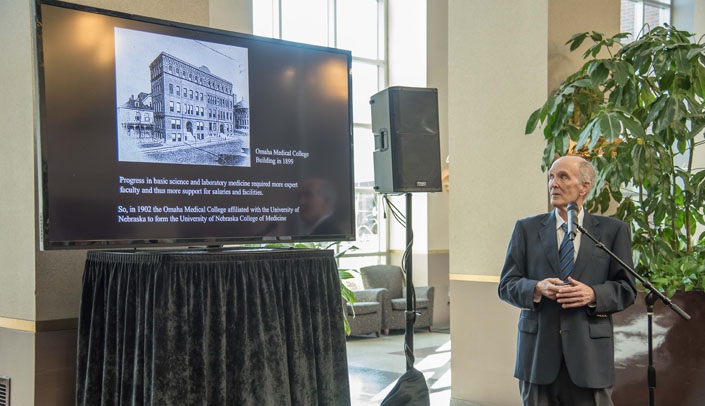Listening to the speakers at the 100th anniversary celebration for University Hospital last week, one thing came through loud and clear – we have come a very long way.
When University Hospital (now called University Tower) opened in 1917, it was licensed for 130 beds. It was the state’s charity hospital and served “the worthy sick,” said Robert Wigton, M.D., professor of internal medicine and the “unofficial historian” of the medical center.
“The excitement surrounding the growth in size and influence of University Hospital over the past 30 years is palpable,” said Michael Sorrell, M.D., professor, internal medicine, and one of UNMC’s legendary physicians. “It’s gone from a modest plant with few full-time faculty to its present explosive growth – both in facilities and faculty. Coupled with its national reputation, it has been just extraordinary.”
Some fun facts about 1917:
- The cost for one day of care in the hospital – $3.
- The world literacy rate was about 23 percent.
- The big technological invention was the light switch.
- University Hospital was located on the western fringe of the city. Today, the area is called midtown – and that’s probably a misnomer.
“Who could have known that a century later our physicians, scientists and researchers would be pushing cancer care to new heights, leading the world in certain types of organ transplants, or creating something called a ‘biocontainment unit’?” said Dan DeBehnke, M.D., M.B.A., CEO of Nebraska Medicine.
“We all become part of that history in some way. It should be inspiring each day to look around and see all that UNMC and Nebraska Medicine are doing in 2017.”
In 1917, about 8 percent of American homes had telephones, said UNMC Chancellor Jeffrey P. Gold, M.D., who joked that “we’re getting back to that same rate” as people today continue to drop their home landlines.
If the visionaries who created University Hospital 100 years ago could see the campus now, Dr. Gold said, they would be blown away by high-tech buildings like the Fred & Pamela Buffett Cancer Center, the Durham Research Center Towers, the Sorrell Center, and the iEXCEL building under construction.
“It’s unmistakable that the lesson those leaders from 100 years ago would see is that this medical center has continued to grow and that the Omaha community has grown with it – and to some degree because of it,” he said.
“Omaha and all of Nebraska are stronger and more vibrant because of the work all of us do here each day.”
